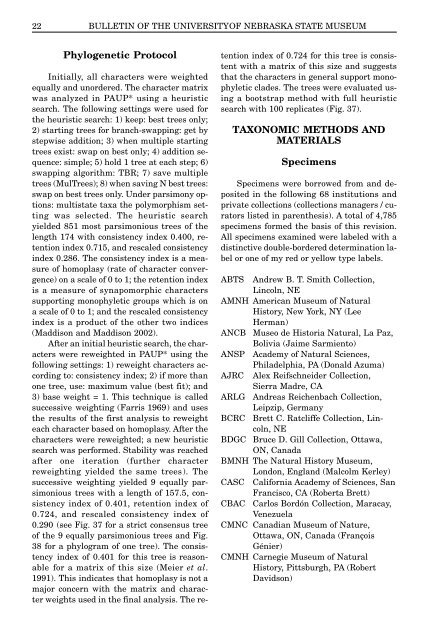Download full text (PDF 4.5 MB) - University of Nebraska State ...
Download full text (PDF 4.5 MB) - University of Nebraska State ...
Download full text (PDF 4.5 MB) - University of Nebraska State ...
Create successful ePaper yourself
Turn your PDF publications into a flip-book with our unique Google optimized e-Paper software.
22 BULLETIN OF THE UNIVERSITYOF NEBRASKA STATE MUSEUM<br />
Phylogenetic Protocol<br />
Initially, all characters were weighted<br />
equally and unordered. The character matrix<br />
was analyzed in PAUP* using a heuristic<br />
search. The following settings were used for<br />
the heuristic search: 1) keep: best trees only;<br />
2) starting trees for branch-swapping: get by<br />
stepwise addition; 3) when multiple starting<br />
trees exist: swap on best only; 4) addition sequence:<br />
simple; 5) hold 1 tree at each step; 6)<br />
swapping algorithm: TBR; 7) save multiple<br />
trees (MulTrees); 8) when saving N best trees:<br />
swap on best trees only. Under parsimony options:<br />
multistate taxa the polymorphism setting<br />
was selected. The heuristic search<br />
yielded 851 most parsimonious trees <strong>of</strong> the<br />
length 174 with consistency index 0.400, retention<br />
index 0.715, and rescaled consistency<br />
index 0.286. The consistency index is a measure<br />
<strong>of</strong> homoplasy (rate <strong>of</strong> character convergence)<br />
on a scale <strong>of</strong> 0 to 1; the retention index<br />
is a measure <strong>of</strong> synapomorphic characters<br />
supporting monophyletic groups which is on<br />
a scale <strong>of</strong> 0 to 1; and the rescaled consistency<br />
index is a product <strong>of</strong> the other two indices<br />
(Maddison and Maddison 2002).<br />
After an initial heuristic search, the characters<br />
were reweighted in PAUP* using the<br />
following settings: 1) reweight characters according<br />
to: consistency index; 2) if more than<br />
one tree, use: maximum value (best fit); and<br />
3) base weight = 1. This technique is called<br />
successive weighting (Farris 1969) and uses<br />
the results <strong>of</strong> the first analysis to reweight<br />
each character based on homoplasy. After the<br />
characters were reweighted; a new heuristic<br />
search was performed. Stability was reached<br />
after one iteration (further character<br />
reweighting yielded the same trees). The<br />
successive weighting yielded 9 equally parsimonious<br />
trees with a length <strong>of</strong> 157.5, consistency<br />
index <strong>of</strong> 0.401, retention index <strong>of</strong><br />
0.724, and rescaled consistency index <strong>of</strong><br />
0.290 (see Fig. 37 for a strict consensus tree<br />
<strong>of</strong> the 9 equally parsimonious trees and Fig.<br />
38 for a phylogram <strong>of</strong> one tree). The consistency<br />
index <strong>of</strong> 0.401 for this tree is reasonable<br />
for a matrix <strong>of</strong> this size (Meier et al.<br />
1991). This indicates that homoplasy is not a<br />
major concern with the matrix and character<br />
weights used in the final analysis. The re-<br />
tention index <strong>of</strong> 0.724 for this tree is consistent<br />
with a matrix <strong>of</strong> this size and suggests<br />
that the characters in general support monophyletic<br />
clades. The trees were evaluated using<br />
a bootstrap method with <strong>full</strong> heuristic<br />
search with 100 replicates (Fig. 37).<br />
TAXONOMIC METHODS AND<br />
MATERIALS<br />
Specimens<br />
Specimens were borrowed from and deposited<br />
in the following 68 institutions and<br />
private collections (collections managers / curators<br />
listed in parenthesis). A total <strong>of</strong> 4,785<br />
specimens formed the basis <strong>of</strong> this revision.<br />
All specimens examined were labeled with a<br />
distinctive double-bordered determination label<br />
or one <strong>of</strong> my red or yellow type labels.<br />
ABTS Andrew B. T. Smith Collection,<br />
Lincoln, NE<br />
AMNH American Museum <strong>of</strong> Natural<br />
History, New York, NY (Lee<br />
Herman)<br />
ANCB Museo de Historia Natural, La Paz,<br />
Bolivia (Jaime Sarmiento)<br />
ANSP Academy <strong>of</strong> Natural Sciences,<br />
Philadelphia, PA (Donald Azuma)<br />
AJRC Alex Reifschneider Collection,<br />
Sierra Madre, CA<br />
ARLG Andreas Reichenbach Collection,<br />
Leipzip, Germany<br />
BCRC Brett C. Ratcliffe Collection, Lincoln,<br />
NE<br />
BDGC Bruce D. Gill Collection, Ottawa,<br />
ON, Canada<br />
BMNH The Natural History Museum,<br />
London, England (Malcolm Kerley)<br />
CASC California Academy <strong>of</strong> Sciences, San<br />
Francisco, CA (Roberta Brett)<br />
CBAC Carlos Bordón Collection, Maracay,<br />
Venezuela<br />
CMNC Canadian Museum <strong>of</strong> Nature,<br />
Ottawa, ON, Canada (François<br />
Génier)<br />
CMNH Carnegie Museum <strong>of</strong> Natural<br />
History, Pittsburgh, PA (Robert<br />
Davidson)
















